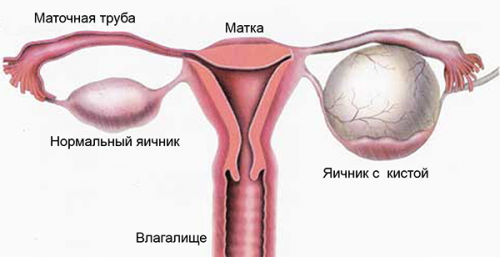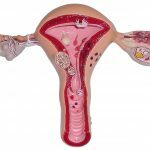Ovarian cysts are caused by a variety of circumstances. And in 10% of cases they are paraovariant. This is the only kind of education that does not degenerate, but still fundamentally spoils life and worsens well-being. Therefore, the interest of women with this diagnosis to how to cure a parovarial ovarian cyst without surgery is natural.
cysts What parovarian cyst
Inside cysts of this type is a liquid grows the formation of parovarialappendage. They are located between the sex gland and the fallopian tube.
The paravarian cyst has a flat surface and a rounded configuration. The liquid that fills it is the protein compounds that make up the majority, and mucin. The growth of education is primarily associated with an increase in the amount of cyst content. It can reach a size of up to 15 cm. The capsule shell is thin, consists of epithelial cells.
The features of the paraovarian cyst prevent it from being able to degenerate into a cancerous tumor. But they can lead to tearing, torsion, which is very painful and dangerous.
Causes of development of pathology
Cysts from the tissues of the ovaries are formed on different occasions. Sometimes, the negative impact of drugs, tobacco, tested in the prenatal period may be the basis. There are also provoking factors:
- inflammatory diseases of the reproductive organs( adnexitis, salpineophoritis);
- thyroid pathology, other endocrine problems;
- abortion;
- chronic stress;
- frequent infections, affecting not only the reproductive organs.

Paraovarian ovarian cyst during pregnancy on fetal development is not affected. But if it is large, there is a risk of its rupture or torsion. A woman feels worse because she is forced to wear a double weight, she may have problems with urination, constipation. The birth will also require more careful maintenance, since with careless movement, rupture of the capsule is not excluded. You can treat a neoplasm only after them, if there is no need for emergency help.

Symptoms of neoplasm
It is impossible to detect the presence of a small cyst without a doctor's examination, it does not appear. With its growth are found:
- discomfort, and then pain in the abdomen, sacrum;
- disorders of the menstrual cycle;
- need to urinate frequently and painfully;
- difficulty in defecation;
- in some cases, a one-sided increase in the volume of the abdomen.
Symptoms become more noticeable when the education is twisted. The pain increases, the temperature may jump, weakness and nausea, cold sweat. The rupture of the capsule leads to a sharp loss of consciousness of pain, other signs of an "acute abdomen".
Types of paraovarian cysts
Formations are formed on one of the gonads, but can grow on both at once. In the first case, there are some differences in the state of health and consequences:
- The paraovarian cyst of the right ovary is found in most of the diagnoses, since this organ has an active blood supply. Another feature of it is the possibility of wall ingrowth in uterine tissue. When developed to a large size, it gives more pronounced symptoms, because it presses on the existing organs nearby. Due to the peculiarities of the ovarian's blood supply, the formation localized on the right increases more rapidly, often has a leg. And complications in the form of suppuration and rupture of the walls in most cases happen precisely with them.
- The paraovarian cyst of the left ovary is less noticeable in symptomatology. More often it happens on a wide base, so the ruptures of these formations occur much less often. Nevertheless, cysts on the left ovary also tend to grow.
The increase in parovarial lesions, as well as the possibility of complications, also depend on another classification:
- Movable( serous) easily move, since they often have a thin stem and fragile walls. They are distinguished by a considerable size.
- Fixed are less dangerous in this respect, but they can develop to a large extent.
Diagnosis of neoplasms
A doctor may be able to detect the presence of a cyst when the patient is examined. Palpation of her abdomen causes pain, on the ovary a foreign formation is probed. But to clarify the nature of the cyst, you also need ultrasound of the pelvic organs. Usually, the doctor sees a capsule with thin walls and clear liquid, distinguishes it from other types of formations.

Traditional treatment of paraovarian cysts
The fight against parovarial types is that it is separated from natural tissues and extracted. The removal of the parovarial cyst of the ovary can be carried out with the dissection of the abdominal wall, that is, with the help of a cavitary operation. The incision is made above the pubis, but this does not exclude long subsequent healing, an impressive loss of blood, a high risk of infection later, as well as a patient's feeling of severe pain during the rehabilitation period.
Laparotomy surgery is often done because of the lack of equipment for gentle intervention. For the last contraindication associated with the size of education, there is no. They can become other pathologies( adhesions, asthma, malignant tumors of other organs, obesity, hernia).
Laparoscopy of the paraovarian ovarian cyst is performed using a device that allows you to see it before removal. Enter it through the puncture, and through other incisions penetrate the formation of tools. The surgeon removes the cyst from the attachment site, clearly seeing how it does it. The recovery period of the patient is shorter and easier for her, she feels better.
 We recommend reading the article on the monthly for the ovarian cyst. From it you will learn about the effect of education on the menstrual cycle, the complications of rupture of the cyst, the ways of normalizing the cycle, the features of the monthly after the operation.
We recommend reading the article on the monthly for the ovarian cyst. From it you will learn about the effect of education on the menstrual cycle, the complications of rupture of the cyst, the ways of normalizing the cycle, the features of the monthly after the operation.
Other ways to get rid of the
cyst If a parovarial cyst is detected at an early stage of development, it is not necessary to operate it. It can grow slowly, then there is a chance that it will help stop the capsule growth and help resorption treatment with folk remedies. They need:
- Aloe, yarrow, St. John's wort, wormwood( all herbs for 50 grams) with the addition of alcohol( 0.5 liters), and honey( 0.5 kg).Plants are placed in 3 liters of boiling water and kept in a thermos day. Then add the remaining ingredients to the infusion. Means taken orally before meals for 1 tbsp.l.three times a day.
- Olive or sunflower oil( 200 ml), boiled egg yolk, beeswax( 30 g).The first component is first heated. Immediately place the wax in it, wait until it melts. Then add the crushed yolk. Fire is turned off when foam appears in the mixture. Allow it to cool, then heat 2 times more to the same condition and cool. The resulting ointment is applied to a tampon that is kept deep in the vagina for 6 to 8 hours.
The above prescriptions for home treatment of parovarial cysts are tested and effective. But their application should begin after examination by a doctor and confirmation of the fact that the operation is not shown. Otherwise, there is a risk of missing out on time, causing possible complications.
